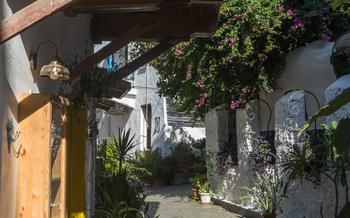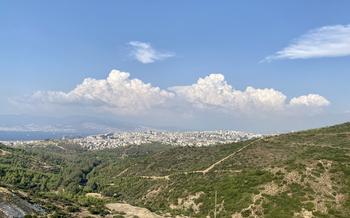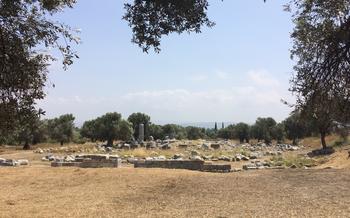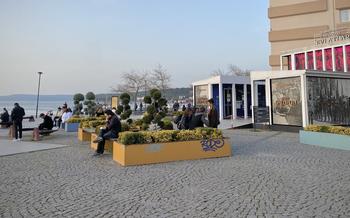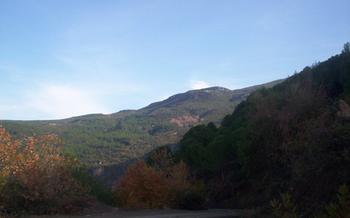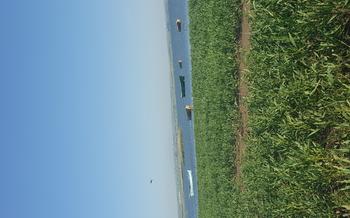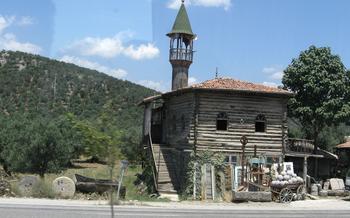
The Ancient City of Thebe
- History of Thebe:
- Getting There
- Exploring the Archaeological Site
- The Theater of Thebe
- The City Walls of Thebe:
- The Temple of Apollo
- The Necropolis of Thebe
- The Museum of Thebe
- Accommodation Options:
- Guided Tours and Entrance Fees
- Best Time to Visit
- Photography and Videography
History of Thebe:
The ancient city of Thebe, located in the Balıkesir province of Turkey, holds a significant place in the region's rich historical tapestry. Founded in the 3rd century BC, Thebe flourished during the Hellenistic period as a major center of trade, culture, and religious devotion. Its strategic position on the fertile plains of the Bakırçay River Valley, coupled with its proximity to the Aegean Sea, made it a thriving hub for both commercial and cultural exchange.
Thebe's historical significance stems from its role as a key city-state within the Achaean League, a powerful alliance of Greek city-states that played a pivotal role in shaping the political landscape of the region. As a member of the league, Thebe contributed to the league's military strength and economic prosperity, further solidifying its status as a prominent city in the Hellenistic world.
Archaeological discoveries and excavations conducted at the site have unearthed a wealth of artifacts and architectural remains, providing valuable insights into the city's past. These discoveries, including well-preserved temples, theaters, and city walls, have shed light on Thebe's urban planning, architectural styles, and the daily lives of its inhabitants.
Getting There
Reaching Thebe from major cities in Turkey is relatively straightforward. From Istanbul, the most convenient option is to take a direct flight to Balıkesir Koca Seyit Airport (BZI). The flight takes approximately 1 hour and 15 minutes, and from the airport, you can either rent a car or take a taxi to Thebe, which is about an hour's drive away.
Alternatively, you can travel by bus from Istanbul to Balıkesir, which takes around 6 hours. From the Balıkesir bus station, you can take a local bus or taxi to Thebe. The journey by bus is more economical but can be longer and less comfortable.
Once in Thebe, finding the archaeological site is easy. It is situated on a hill overlooking the city, and you can follow the signs from the main road.
Pro Tip: For the best experience, allocate a full day to explore Thebe. Arrive early to beat the crowds and have ample time to wander through the ruins, soak in the atmosphere, and appreciate the history of this ancient city.
Exploring the Archaeological Site
The ancient city of Thebe is a treasure trove of archaeological wonders, inviting visitors to journey through time and uncover its rich history. As you step into the site, you'll be greeted by a network of well-preserved streets that once bustled with life. Admire the impressive city walls that once protected Thebe from invaders, and marvel at the intricate carvings and inscriptions that adorn the remaining structures.
Among the highlights of the site is the theater, a magnificent construction that could accommodate thousands of spectators. Imagine the roar of the crowd as they watched captivating performances that brought Greek mythology to life. The agora, the city's central marketplace, is another must-see. Stroll through its colonnaded stoas, where merchants once displayed their wares, and envision the lively atmosphere as people bartered and exchanged goods.
Don't miss the Temple of Apollo, a sacred sanctuary dedicated to the revered Greek god. Admire its grand architecture and intricate sculptures, which offer a glimpse into the religious beliefs and rituals of Thebe's ancient inhabitants. As you explore, keep an eye out for the many other ruins that dot the site, each telling its own story about Thebe's glorious past.
The Theater of Thebe
The theater of Thebe is an impressive and well-preserved structure that stands as a testament to the city's cultural and artistic heritage. Built in the Hellenistic period, the theater had a seating capacity of approximately 3,000 spectators. Its horseshoe-shaped auditorium is divided into three sections by two diazomata, or horizontal aisles. The stage is adorned with elaborate reliefs and sculptures, depicting scenes from Greek mythology and history.
The theater served as a venue for a variety of performances, including plays, concerts, and religious ceremonies. It was a central gathering place for the community, where citizens could come together to enjoy entertainment, exchange ideas, and celebrate important events. The theater also played a significant role in the city's religious life, as it was used for performances honoring the gods and goddesses of the Greek pantheon.
Today, the theater of Thebe is in a remarkably good state of preservation. Restoration efforts have been undertaken to ensure its continued integrity and accessibility for visitors. It stands as a symbol of the city's rich cultural heritage and offers a glimpse into the vibrant and sophisticated society that once thrived here. Visitors can explore the theater's auditorium, stage, and backstage areas, and imagine the lively atmosphere that would have filled the space during ancient times.
The City Walls of Thebe:
Thebe's ancient fortifications, known as the city walls, stand as a testament to the city's strategic importance and resilience. Constructed using sturdy materials like stone and brick, these walls were designed to protect the city from invaders and maintain its autonomy. Despite the passage of time, significant sections of the walls have survived, providing a glimpse into the defensive measures employed by Thebe's inhabitants.
The walls, which once encircled the entire city, featured a combination of solid ramparts and fortified gates. These gates, such as the Main Gate, served as controlled entry points and were often flanked by towers for added security. The walls' thickness and height, combined with their strategic placement, made Thebe a formidable force to reckon with, effectively deterring potential attackers.
Exploring the remnants of the city walls offers a unique perspective on Thebe's defense mechanisms and urban planning. Visitors can trace the walls' course, marveling at their impressive construction and imagining the bustling life that once took place within the city's protected boundaries.
The Temple of Apollo
Among the sacred structures of Thebe, the Temple of Apollo stands as a testament to the city's deep reverence for the Olympian deity. Apollo, the god of music, prophecy, and healing, held a special place in the hearts of the Thebians. The temple, dedicated to his honor, was a magnificent edifice that reflected the city's prosperity and devotion.
Constructed in the 2nd century BC, the Temple of Apollo showcased a blend of architectural styles, drawing inspiration from both Greek and Roman influences. Its imposing facade featured intricate carvings and sculptures depicting scenes from Greek mythology, particularly those associated with Apollo's divine attributes.
The interior of the temple was adorned with exquisite mosaics and frescoes, some of which have survived the ravages of time. These artistic masterpieces depicted scenes of Apollo's exploits, his interactions with mortals, and his role as a divine protector of the city.
Sadly, the Temple of Apollo, like many other structures in Thebe, has not escaped the passage of time and the destructive forces of nature. Over the centuries, earthquakes and natural disasters have taken their toll, leaving only fragments of its former glory. However, the ruins that remain still evoke a sense of awe and wonder, inviting visitors to contemplate the grandeur of this once-magnificent temple.
Excavations around the Temple of Apollo have yielded a wealth of artifacts and inscriptions that have shed light on the religious practices and rituals performed within its sacred walls. These findings have helped scholars reconstruct the intricate tapestry of beliefs and traditions that shaped the spiritual life of the ancient Thebians.
The Necropolis of Thebe
Located just outside the ancient city walls, the necropolis, or cemetery, of Thebe offers a glimpse into the funerary customs and beliefs of its inhabitants. This vast burial ground, dotted with various types of tombs, provides a unique opportunity to explore the lives and deaths of Thebe's citizens.
The necropolis features a diverse range of tombs, from simple pit graves to elaborate chamber tombs. These tombs vary in size and complexity, reflecting the social status and wealth of the deceased. Some tombs are adorned with intricate carvings, inscriptions, and colorful frescoes, offering valuable insights into the religious beliefs and artistic traditions of ancient Thebe.
Archaeological excavations within the necropolis have unearthed numerous artifacts, including pottery, jewelry, and grave goods, which shed light on the daily lives and funerary practices of Thebe's people. These artifacts provide clues about the beliefs regarding the afterlife, the rituals associated with burial, and the social customs surrounding death and mourning.
Exploring the necropolis of Thebe is a fascinating journey into the past, allowing visitors to connect with the ancient inhabitants of the city and gain a deeper understanding of their culture, traditions, and beliefs about the hereafter.
The Museum of Thebe
Within the confines of the archaeological site, or in close proximity, visitors can delve deeper into the history and culture of Thebe through its dedicated museum. This treasure trove of artifacts, unearthed during excavations, offers a tangible connection to the city's past.
Displays of pottery, sculptures, inscriptions, and other relics provide a glimpse into the daily lives, artistic traditions, and religious practices of Thebe's inhabitants. From intricately painted ceramics to finely carved statues, these artifacts narrate the story of a vibrant civilization.
The museum serves as a gateway to understanding the rich tapestry of Thebe's heritage. Through its curated collections, visitors can piece together the fragments of the city's history and gain a deeper appreciation for its enduring legacy.
Accommodation Options:
Balıkesir offers a range of accommodation options to suit different budgets and preferences. For those seeking a convenient and immersive experience, staying in a hotel or guesthouse near the archaeological site is recommended. This allows for easy access to Thebe's ruins and minimizes travel time. Several mid-range hotels and guesthouses are located within walking distance, providing comfortable rooms and basic amenities.
For travelers seeking a more luxurious stay, there are upscale resorts and boutique hotels in the surrounding area. These establishments often offer breathtaking views of the countryside and additional amenities such as spas, pools, and fine dining restaurants. While slightly further from the site, they provide a relaxing and opulent retreat after a day of exploration.
Budget-conscious travelers can opt for hostels or guesthouses that cater to backpackers and young adventurers. These accommodations offer shared dormitories or private rooms at affordable rates. Hostels often have communal areas where guests can socialize, share travel stories, and plan their excursions.
When selecting accommodation, consider the duration of your stay, budget, and desired level of comfort. Booking in advance, especially during peak tourist season, is advisable to secure your preferred option.
Guided Tours and Entrance Fees
Thebe offers guided tours in various languages, providing visitors with a deeper understanding of the site's history, architecture, and significance. Professional guides can lead you through the ruins, highlighting important features and sharing insights into the daily lives of the ancient inhabitants. Guided tours are highly recommended for those seeking a more immersive and educational experience.
The entrance fee to the archaeological site is nominal, and additional charges may apply for guided tours or special exhibitions. It is advisable to purchase tickets in advance, especially during peak tourist seasons, to avoid queues and secure your spot. Online booking options are available on the official website of the Ministry of Culture and Tourism.
When planning your visit, consider the availability of guided tours in your preferred language and book accordingly. Group discounts or family packages may be offered, so inquire about these options when making your reservation. Guided tours typically last for around two hours, allowing ample time to explore the main attractions of Thebe.
Best Time to Visit
The best time to visit Thebe is during the shoulder seasons, from April to May and from September to October. During these months, the weather is generally mild and pleasant, with warm days and cool nights. The summer months, from June to August, can be hot and crowded, especially during the peak tourist season. Winters, from November to March, can be cold and rainy, making it less ideal for outdoor exploration.
It's advisable to avoid visiting Thebe on weekends and public holidays, as the site tends to be more crowded with local tourists. If you're looking for a tranquil experience, consider visiting on a weekday or during the early morning hours.
If you plan to visit Thebe during a specific event or festival, it's essential to check the dates in advance and plan accordingly. Some popular events include the Balıkesir Culture and Art Festival in June, the Balıkesir International Olive Oil Festival in October, and the Thebe Theater Festival in July.
Photography and Videography
When visiting the ancient city of Thebe, capturing the essence of its ruins, landscapes, and artifacts through photography and videography is a natural desire for many travelers. Here are some guidelines and tips to help you make the most of your photographic journey:
- Respect the Site's Integrity:
-
Always prioritize the preservation of the archaeological site. Avoid touching or leaning against fragile structures, and be mindful of your surroundings to prevent any damage.
-
Composition and Lighting:
-
Take advantage of the natural light to enhance your photographs. The golden hours of sunrise and sunset often create stunning lighting conditions for capturing the ruins' beauty.
-
Capture the Details:
-
Don't just focus on the grand structures; zoom in to capture the intricate details of friezes, mosaics, and inscriptions that tell stories of the past.
-
Panoramic Views:
-
Seek elevated vantage points to capture panoramic shots of the site and the surrounding landscape. Drone photography can offer unique perspectives, but always follow local regulations and guidelines.
-
People and Interactions:
-
Incorporate people into your shots to add a sense of scale and life to the ancient ruins. Capture candid interactions between visitors and the site's surroundings.
-
Photography Permits:
-
Check if special permits are required for professional photography or filming. Some sites may have restrictions or fees associated with commercial use of images.
-
Share Your Experience:
- Share your photographs and videos responsibly, ensuring you credit the site and respect the privacy of other visitors. Use social media platforms to connect with fellow travelers and share your Thebe experiences.

